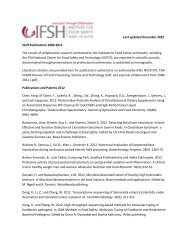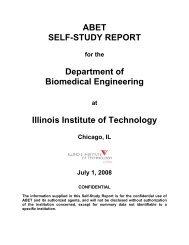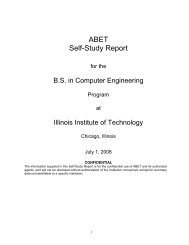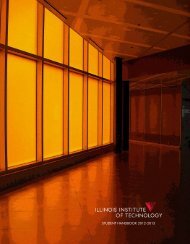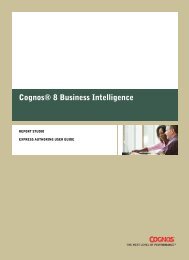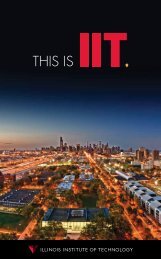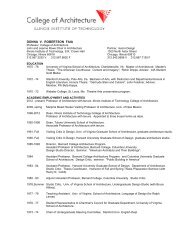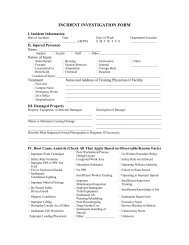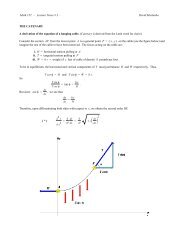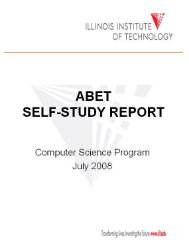Copyright & Disclaimer Information - Illinois Institute of Technology
Copyright & Disclaimer Information - Illinois Institute of Technology
Copyright & Disclaimer Information - Illinois Institute of Technology
You also want an ePaper? Increase the reach of your titles
YUMPU automatically turns print PDFs into web optimized ePapers that Google loves.
College <strong>of</strong> Architecture<br />
Department Web site: www.arch.iit.edu<br />
Now, in the new century, architecture must fill an ever<br />
more demanding role in asserting human values in a rapidly<br />
changing, technology-driven and increasingly complex<br />
global society. The integration <strong>of</strong> new construction, along<br />
with the conservation <strong>of</strong> the old, brings together current<br />
issues <strong>of</strong> urban housing, commercial development, infrastructure<br />
and transportation, along with critical concerns<br />
for energy and a sustainable environment. The resulting<br />
cultural values <strong>of</strong> community development must be adaptable<br />
to both domestic and international contexts, and<br />
thoughtful to the consequences <strong>of</strong> what we build.<br />
Drawing strength from its Mies van der Rohe heritage,<br />
its key position in the legacy <strong>of</strong> Modernism, its location in<br />
Chicago, and its connections to progressive practitioners<br />
and emerging global practices, the College <strong>of</strong> Architecture<br />
<strong>of</strong>fers the pr<strong>of</strong>essional, five-year Bachelor <strong>of</strong> Architecture<br />
(B.Arch.) degree. Accredited by the National Architectural<br />
Accrediting Board (NAAB), this well-established degree<br />
program prepares architects to use communication and<br />
analytical skills to provide inventive solutions to a broad<br />
range <strong>of</strong> design problems.<br />
The objectives <strong>of</strong> the B.Arch. program prepare architects<br />
to respond to an increasingly complex global condition,<br />
within cities and beyond. Informed by humanist ideals,<br />
our graduates combine technical expertise and environmental<br />
awareness to design and execute individual<br />
buildings as well as sensitively planned landscapes at<br />
any scale, in any material. Consisting <strong>of</strong> tenured faculty<br />
and practicing architects, our teachers are committed to<br />
training and educating a diverse student body for a broad<br />
range <strong>of</strong> pr<strong>of</strong>essional career opportunities in architecture<br />
and the construction industry. Integrating advanced digital<br />
technology and design studio training, our program<br />
prepares our graduates to:<br />
• Design functional, compelling buildings to meet the<br />
needs <strong>of</strong> a complex, changing world.<br />
• Work collaboratively with allied pr<strong>of</strong>essionals<br />
(engineering, landscape architecture, construction<br />
management, etc.) to produce quality built environments.<br />
• Enter the pr<strong>of</strong>ession equipped with an integrated<br />
knowledge <strong>of</strong> complex construction technologies,<br />
craftsmanship, materials, and an inspired sense<br />
<strong>of</strong> design excellence.<br />
• Articulate in two-dimensional and three-dimensional<br />
visual form a contemporary vision for architectural<br />
excellence responsive to the 21st century’s cultural,<br />
economic, regulatory, environmental, ethical, and<br />
material contingencies that condition the built world.<br />
• Take leadership roles throughout their lives to support<br />
design excellence, develop technical expertise,<br />
advance pr<strong>of</strong>essional practice, practice ethical<br />
integrity, and promote respect for the architect in<br />
contemporary society.<br />
<strong>Copyright</strong> & <strong>Disclaimer</strong> <strong>Information</strong>: <strong>Copyright</strong> © 1994, 1995, 1996, 1997, 1998, 1999, 2000, 2001, 2002, 2003, 2004, 2005, 2006, 2007. CollegeSource®, Inc. and Career Guidance Foundation. CollegeSource® digital catalogs are derivative works owned and copyrighted by CollegeSource®, Inc. and Career Guidance Foundation. Catalog content is owned and copyrighted by the appropriate school. While CollegeSource®, Inc. and Career Guidance Foundation provides information as a service to the public, copyright is retained on all digital catalogs.<br />
<strong>Copyright</strong> & <strong>Disclaimer</strong> <strong>Information</strong>: <strong>Copyright</strong> © 1994, 1995, 1996, 1997, 1998, 1999, 2000, 2001, 2002, 2003, 2004, 2005, 2006, 2007. CollegeSource®, Inc. and Career Guidance Foundation. CollegeSource® digital catalogs are derivative works owned and copyrighted by CollegeSource®, Inc. and Career Guidance Foundation. Catalog content is owned and copyrighted by the appropriate school. While CollegeSource®, Inc. and Career Guidance Foundation provides information as a service to the public, copyright is retained on all digital catalogs.<br />
IIT Undergraduate Bulletin 2006–2008<br />
Architecture<br />
• Consider all aspects <strong>of</strong> the built environment to insure<br />
a sustainable and planned integration <strong>of</strong> architecture<br />
with the natural environment and its resources. .<br />
To understand architecture in its global context, IIT students<br />
are encouraged to travel outside the United States to<br />
study modern and historic buildings. Students may enroll<br />
in the European Study Program, a Paris-based studio<br />
defined by travel, drawing and projects derived from contemporary<br />
urban landscapes. Recent advanced studios have<br />
been situated for one month in Asia and South America.<br />
The College’s roots are firmly embedded in Chicago’s architectural<br />
history. Creative pioneers like Sullivan, Jenney,<br />
Root, Burnham and Wright produced a body <strong>of</strong> work that<br />
established the principles <strong>of</strong> modern architecture. These<br />
architects were inspired by exciting new engineering possibilities,<br />
yet they never wavered from the unifying belief in<br />
a rich cultural expression <strong>of</strong> architecture for their time.<br />
They also believed in education and, in 1895, combined a<br />
course <strong>of</strong> study in drawing and construction at the Art<br />
<strong>Institute</strong> <strong>of</strong> Chicago, with the support courses <strong>of</strong> history,<br />
mathematics and engineering from the then Armour<br />
<strong>Institute</strong> <strong>of</strong> <strong>Technology</strong>. The catalog for this new program<br />
was called the Chicago School <strong>of</strong> Architecture.<br />
Out <strong>of</strong> these beginnings, the College’s faculty and students<br />
continue to engage with complexities that inform architectural<br />
education and future practice. Located in one <strong>of</strong> the<br />
world’s greatest cities for the study <strong>of</strong> architecture, the<br />
most outstanding architectural and engineering resources<br />
<strong>of</strong> Chicago provide both faculty and reinforcement <strong>of</strong> the<br />
educational mission. Moreover, S.R. Crown Hall, designed<br />
by Mies van der Rohe, is the ultimate space to study<br />
architecture. Set within the Mies-designed campus, it has<br />
become recognized as one <strong>of</strong> the most significant buildings<br />
<strong>of</strong> the 20th century.<br />
Current curricular emphases are in digital applications<br />
(including Building <strong>Information</strong> Management), advanced<br />
technologies, design and theory, Landscape Architecture<br />
and its relationship to Architecture, development and<br />
Design/Build, Sustainability and Planning, and<br />
History/Theory/Criticism. A dynamic campus center by<br />
Rem Koolhaas and residence hall by Helmut Jahn have<br />
energized the historic campus landscape. To meet<br />
expanded studio and faculty requirements, the College<br />
has adapted important Mies buildings for additional<br />
teaching and design/build projects.<br />
With a demonstrated legacy <strong>of</strong> excellence, IIT Architecture<br />
seeks to become a force for designing built environments<br />
<strong>of</strong> high quality through the incorporation <strong>of</strong> planing, technology,<br />
materials, space and formal generation. The<br />
responsible integration <strong>of</strong> these attributes is promoted to<br />
accentuate the historical, social, cultural, and environmental<br />
imperatives requisite to better society.<br />
29




